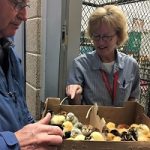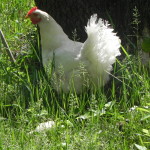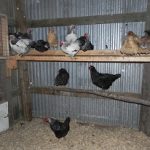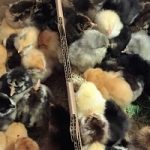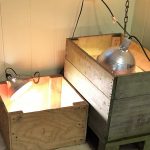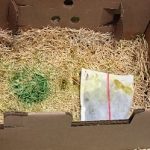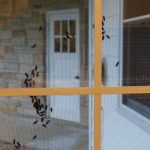26 Hours Old: Baby Chicks Arrive
Baby Chicks Find a Home at Winding Pathways
The call from our post office came at 6 a.m. “Could you please come soon and pick up a box of peeping baby chicks,” requested the pleasant postal worker. Soon we were in the car en-route to retrieve the babies. We were excited, but the story really began months earlier.
The Girls are Getting Old
Our 13 hens were laying well but we knew they were on the downside of production. Young hens, called pullets, start laying when they are around 20 to 24 weeks old. During the approximately 14 months of their lay cycle we expect about 275 to 300 eggs per hen. Then they declare a vacation, take a break, shed their worn feathers, fatten up a bit, grow new feathers, increase their calcium, and after six or eight weeks begin their second lay cycle. They’ll produce fewer eggs this time and as they continue to age we can expect ever fewer eggs. So, about every third year we order baby chicks that grow into pullets to replace the old girls. The process takes time and requires planning.
Getting Ready for Baby Chicks
Around Christmas we began planning our new chick order. This year we cooperated with two friends. Each wanted some chicks but not a full order of 25. So, we placed a joint order with Hoover’s Hatchery in the tiny town of Rudd, Iowa. Leafing through their paper catalog and double checking their website helped us decide to order 50 chicks of diverse breeds. They’d collectively be a rainbow of feather colors and would lay light and dark brown, white, and blue/green eggs. We placed our order in January. Then, preparation really began.
Preparing for the Arrival
Our old chickens are in a coop Rich built in the corner of our small barn. We wanted to keep them until the new ones start laying in mid-summer. You don’t put baby chicks in with old ones. It just doesn’t work. Birds, like most creatures, are territorial and the old birds will kill the newcomers. The hens and chicks need to be kept apart. So, Rich made a second coop next to the existing one but separated by a wire and plywood wall. Inside the new coop, he made a large plywood box, complete with a plywood lid and two heat lamps to keep the babies warm until their feathers grew in and the weather warmed.
Hoover’s Hatchery sent a confirmation that the babies would arrive on March 15th. Gulp, the Ides of March. And, as it turned out, one of the colder days of winter.
Hoover’s also confirmed the breeds we ordered and the gender of each. We like having chicks arrive just as the winter is starting to wane and the weather is warming up. Normally our heat lamps keep the baby chicks warm in their brooder in the barn, but mother nature threw us a last-minute curve in 2017. A zero-degree low temperature was predicted. The lamps just couldn’t keep the birds warm enough in that chill, so just before arrival day Rich made two temporary brooders out of wooden boxes we had on hand. He set them up downstairs in the house in the same room as our wood stove. It’s the coziest room in the house. A couple of small lights in each wooden box was all that was needed to keep the chicks comfy in the heated room.
We hoped the arrangement would only last a few days until the weather warmed and the babies could move into the barn brooder. That many baby chicks start to smell after a few days. Everything was ready by the evening of March 13. The next two nights were frigid but the temporary brooders stayed warm.
- Chicks stay warmer crowded in a box for the journey.
- A temporary shelter until temperatures moderate.
- Warm packs keep the chicks warm during shipping.
Each of the small brooders had a quarter inch of wood chips on the floor and a simple plastic drinking water dispenser that we had bought at a local store. An egg carton served as a temporary feeder sturdy enough to last only a couple of days until we switched to metal feeders.
Why Baby Chicks Can Be Shipped in the Mail
Baby chicks have an amazing adaptation that allows hatcheries to ship them all over the world. While they develop as embryos inside the egg they draw nutrition from the yolk. After 21 days in Hoover’s Hatchery incubators the chicks emerge wet and gangly. But, much of the yolk remains inside them and provides plenty of nutrition for their first few days of life.
As soon as their wet fluff dries Hoover’s staff remove the tiny babies from the incubators, sorts them by gender and breed, and puts them in shipping boxes that soon go to the post office. Every week hundreds of boxes and thousands of chicks get sent every which way. They safely reach destinations as far away as Florida and Alaska. If it’s cold out, Hoover’s slips warming pads inside the box with the chicks. Because they are still living off their yolk the babies don’t need to eat or drink during their journey which is often by airplane.
Our chicks arrived at the Cedar Rapids Post office when just a day old and by the time we got them to the house they were but 26 hours old! All 52 chicks arrived safe and sound, and loudly peeping. We opened the box at the post office to make sure they were all alive and because the postal service workers really wanted to take a peek at them. Then we hustled home. Rich gently picked each baby up, dipped its bill into the waterer in the brooder so they knew where to drink, and released it. Soon the shipping box was empty and the two brooders full of peeping babies. They were thirsty, hungry, and sleepy and began pecking at their food, drinking water, and tumbling over to the floor for frequent naps.
- Chicks know how to forage, but have to be introduced to water.
- Only a day old, chicks learn to drink.
- Day old chicks peck like pros at the nutritious feed.
Baby chicks are fun to watch. It’s a miracle of nature that an animal so young can feed itself and drink water without being tutored by a mother.
Baby Chick Nutrition
Adult chickens are omnivores that love seeds, worms, insects, fruit, and all sorts of other tidbits they find while scratching around outside. Baby chicks need a high protein diet and are too young to forage on their own, so we buy high protein feed called chick starter. It will be their main diet until they are old enough to forage in the run in a few months. Just before they start laying in about five months we’ll switch them to a layer feed that’s a little lower in protein but higher in calcium to meet the nutritional needs of a laying hen.
Making the Summer Switcheroo
As the chicks grow they’ll get too crowded in the brooder. By then spring will be in full glory and the weather warmer. Rich will take apart the brooder and let the adolescent birds roam around the full coop. They’ll grow fast and by early summer will need even more space. That will be time to say goodbye to the old hens and our one rooster. We put a notice on Craig’s list and have no problem selling the old birds for a buck apiece – a bargain for someone who wants older hens.
As soon as they are gone Rich will scoop the litter (a word that means the wood chips mixed with dry manure on the floor) and sprinkle it lightly on the garden. When used sparingly chicken manure is outstanding fertilizer that will stimulate the lettuce, chard, okra, tomatoes and squash that we harvest in summer. Then he’ll spray down the roosts, nests, feeders, walls and floor with a mild bleach/water solution and give it a day or two to dry. Next, are added a few inches of new clean wood chips to the floor and we welcome the youngsters to enjoy their new home.
This coop has a small door, called a pop hole, that leads outside to a huge fenced in run where the birds enjoy basking in the sun or sitting in the shade of a few small trees. They hunt for bugs and worms, exercise, and socialize outside or inside wherever they choose to be.
What Adult Chickens Need
Outfitting the coop for adult chickens is simple. Rich, being the consummate forager himself, made a feeder of scrap wood. Manufactured ones also work well. The birds always have a few buckets of drinking water and clean litter. A 2″X4″ with edges rounded off that spans the coop about four feet above the floor makes a comfortable roost, where the birds lounge during the day and sleep at night. It’s their bed. Can you imagine sleeping on your feet perched upright? Chickens do it every night. Many years ago, we salvaged a wooden nest that has eight nests, each about 12” by 12”. That’s where the chickens lay eggs. Our chickens always get fresh feed and water daily, and we harvest their eggs each afternoon.
Raccoons, opossums, skunks, mink, cats, and roving dogs all love to kill chickens, but mostly they prowl night. At dusk chickens always head inside and hop up to their roosts to sleep for the night. Rich or Marion closes and secure the latched pop hole door. Predators can’t reach the safely sleeping chickens. The chickens hop off the roost at dawn and greet the new day.
- Sweet smile.
- Newborn Orpington
- Children learn care of chicks.
At Winding Pathways, we love our chickens. They eagerly gobble kitchen scraps that otherwise would end up in the compost bin or trash and return us the world’s best eggs. We learn plenty from watching our chickens. Children grow up understanding where food comes from and how to care for animals. Over the years, we’ve learned they are remarkably intelligent with a well-defined social structure. They also have an extensive vocabulary. The different sounds they make mean different things. When given plenty of space, great care, and good food, chickens are clean, pleasant, and fun to be around. We wouldn’t want to live without their company and delicious eggs.

